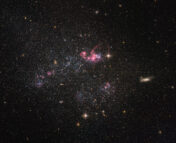Title : A supermassive black hole in an ultra-compact dwarf galaxy
Authors: Anil C. Seth et al.
First Author’s Institution: Department of Physics and Astronomy, University of Utah, 115 South 1400 East, Salt Lake City, Utah 84112, USA
Status: Published in Nature, open access version available (arXivID: 1409.4769)
Galaxies come in many different shapes, sizes, colours and ages, and understanding what drives galaxies to evolve the way that they do puzzles astronomers everyday. But occasionally, we come across a galaxy that makes everyone go ‘huh?’, which is the case for arguably one of the less impressive-looking galaxies seen in Figure 1.

Figure 1 shows two large well-known galaxies: NGC 4647 and M60 (also known as NGC 4649). These galaxies are members of the Virgo Cluster, which lies around 54 million lightyears from our own solar system. However, M60 has a very interesting little friend called M60-UCD1. This galaxy is named as an ‘ultra-compact dwarf’ in that it’s very small and very dense as far as galaxies generally go. The effective radius (the radius which contains half of the total light of the galaxy) of M60-UCD1 is only 24 parsecs (78 lightyears), but packs a mass of 140 million solar masses. Astronomers are not entirely sure how these objects form, and there may be multiple ways that these objects can come about. For this object however, the most likely scenario is that this was once a much larger galaxy. The authors present the suggestion that M60-UCD1 has been tidally stripped due to it having a close call with its giant friend M60. This means that galaxies have interacted with each other and the gravitational force of M60 has disrupted the stars, particularly in the outer parts of M60-UCD1. The reason for motivating this scenario is due to something pretty extraordinary going on in the centre.
It’s well believed that all massive galaxies host supermassive black holes (SMBHs) at their centres. Observations also show a tight relation between bulge mass and SMBH mass, suggesting that they both evolve and grow simultaneously. But the SMBH in the centre of these galaxies is typically less than 1% of the total mass of the bulge of the galaxy. From the mass of the stars in M60-UCD1, we would expect a SMBH mass of approximately 1 million solar masses. But the authors of this paper deduce a SMBH mass of 21 million solar masses. This is 15% of the total mass of the galaxy! This indicates something weird is going on.
So how on Earth do they measure the mass of a SMBH? To measure the mass of stars, we measure their light (or luminosity) and get the mass that way. But black holes are…black (they don’t emit any light), so we can’t do that. Instead the authors of this paper perform dynamical modelling of the galaxy, which is essentially modelling the motions of particularly the stars, but also the dust and the gas within a galaxy. The velocity at which these components move has a dependence on the mass contained within the galaxy. Studying the rotation of the stars in M60-UCD1 gives us information about the stellar component itself, the SMBH and also the dark matter within the galaxy. (For more information on dark matter in galaxies see these astrobites here and here.)
We can see below a simulation (made by one of the coauthors on this paper) laid over the image of M60 and M60-UCD1, demonstrating a possible interaction between these two galaxies, where the initial galaxy that later was left as M60-UCD1 was a larger elliptical galaxy of 10 billion solar masses. And of course the beauty of simulations means we can end up with the UCD galaxy perfectly where it’s observed!
So we’re pretty certain this is the nucleus of a once larger galaxy. Now what does this individual galaxy mean for the wider Universe? Well many UCDs have been observed in the past, and they’ve all had similar unexplained properties that no one has been able to explain in as much detail as M60-UCD1. So the authors infer that perhaps this particular population of UCDs all contain SMBHs. This means that when we look at a cluster of galaxies for example, assuming just the massive galaxies contain SMBHs is most likely wrong! Including these UCDs may more than double the number of SMBHs, resulting in a large increase in the massive black hole number density in our local Universe. Future work is still being conducted on this, but being able to see the motion of these stars particularly very close to the centres in these dwarf galaxies requires the galaxies to be relatively close by. And after all, studying objects that are ultimately impossible to directly observe is always going to be a challenge!




